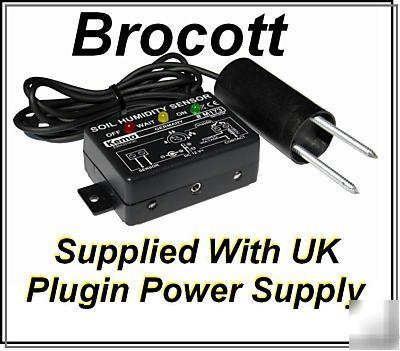Environmentally Conscious and Economically Sound Machine Dismantling Forum > Madison, WI
> Agriculture and Food
> Combines
> Electronic soil moisture sensor - irrigation automation
Electronic soil moisture sensor - irrigation automation
Electronic Soil Moisture Sensor Module
Soil Moisture / Humidity Sensor
The soil humidity is measured after switching on the operating voltage.
The module will remain switched on for 18...30 minutes if the soil is too dry and will switch off again. You can therefore connect various devices such as buzzers, irrigation pumps etc that will automatically switch on and off with the cycle of the moisture sensor.
If the soil is moist enough, the device switches to "Pause" for about 18...30 minutes and tkaes a new measurement periodically there after. The sensitivity is full adjustable to allow for a variety of soil moistures and irrigation needs.
This continues as an infinite loop unless the operating voltage is switched off.
* Operating voltage: 12 VDC stabilized > 130 mA, jack bush 3.5 mm
* Display: 3 LEDs: "On" ... "Off"..."Pause"
* Switching contact: potential-free relay contact 1 x On max. 3 A (up to 25 V or also 230 V ~, see description)
* Connections: screw terminals
* Time delays: approx. 18 - 30 minutes in each case
* Switching threshold: continuously adjustable
* The basic device must be mounted in a dry place.
* Dimensions soil humidity sensor: diameter approx. 30 x 64 mm plus 2 galvanized metal pins approx. 4 x 40 mm
* Dimensions basic device: approx. 70 x 50 x 28 mm without fixing legs
Manufacurers Official Data Sheet...
The soil humidity is measured with the sensor according to the principle of electric resistance. The more humid the soil, the lower the measured resistance value. The reaction point (i.e. when the relay switches the pump on) is adjusted with the trimming potentiometer.
Control of the soil humidity in gardens, fields and grasslands. Switching on of a spray-irrigation system when the soil becomes too dry.
Assemble the device in a dry and weatherproof place. Put the humidity sensor with the metallic heads into the soil (the metallic heads must be put completely into the soil, the black handle juts out of the grass). You have to measure at the spot, which is also reached by the lawn spray-irrigation system. So the sensor measures in a depth of approx. 30...40 mm. If you have a field and it is important to you that the soil will be kept humid in deeper layers, then you may also bury the complete sensor including the handle deeper. The measurement then takes place at the spot where the metallic feeler pins of the sensor are. The cable towards the sensor may be prolonged up to 20 m (normal bipolar cable). The basic device requires an operating voltage of 12 V stabilized direct current voltage. Commercial stabilized plug power supplies 12 V, which have a 3.5 mm jack plug as output and where the positive pole is to the fore of the point of the jack plug may be employed. Most of the power supply units available in specialized trade include multi-plugs and the polarity is switchable. The jack plug is inserted into the jack of the basic device. An LED at the device lights up. If you want to water your garden only at certain times of the day or certain weekdays, you will need a timer. Such a timer to be inserted between the socket and plug power supply is available as daily or weekly timer in a specialist shop. Then this timer has to be programmed in such a manner that the clock only switches on at the times desired by you and then sets the soil humidity sensor into operation via the connected plug power supply. The soil humidity sensor switches on the connected load (pump, magnetic valve) via a relay. This relay contact in the module has been approved by us for voltages up to max. 25 V (AC or DC), switching current max. 3 A. The relay itself may also switch voltages up to 230 V AC 3A. But for this purpose additional safety precautions such as protection against accidental contact, interposed fuses, etc. are required. If you want to switch voltages > 25 V, this should be done by an approved electrician who will also adhere to the safety regulations of the VDE (Association of German Electricians) and will install the module safely in accordance with the valid legal safety regulations.
The device is ready for operation when the soil humidity sensor receives operating voltage from the power supply unit and the sensor has been connected and also been put into the soil. There is a small sliding switch in the device to the right of the board. If this is slid upwards (on), the device operates with a time delay of about 18...30 minutes. This will then look as follows:
After switching-on it is measured whether the soil has to be irrigated. If yes, the built-in relay turns on the connected pump for about 18...30 minutes. If no, the module waits for about 18...30 minutes and then measures the soil humidity again. This continues as infinite loop until the operating voltage is switched off. If the small sliding switch is slid downwards, the time delay of approx. 18...30 minutes is switched off and the device measures the soil humidity continuously and turns on the irrigation pump immediately and without time delay in case of need. You should, however, use this adjustment for your first tests only. The sensitivity is adjusted with the trimming potentiometer (i.e. as from which soil humidity the irrigation shall start), to the left: low soil humidity, to the right: high soil humidity.
